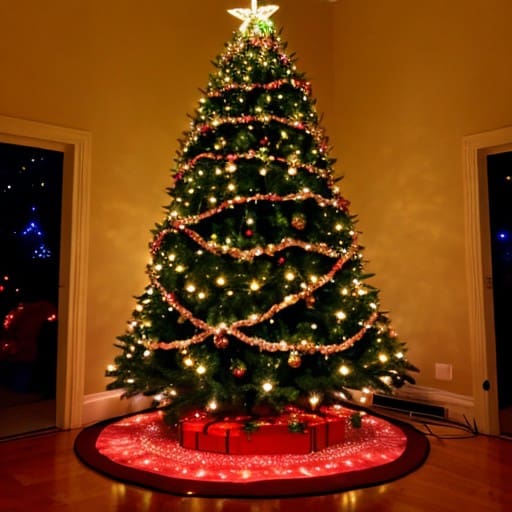Ah, Christmas! The season of joy, family gatherings, and of course, Christmas trees. But have you ever wondered what happens to all those unsold Christmas trees? Do they just magically disappear into thin air?
Well, no, they don’t. In fact, there’s a lot that happens to unsold Christmas trees, and it’s not all bad news.
First of all, let’s understand why there are unsold Christmas trees in the first place. The reason is simple – not all trees are created equal. Some trees are too big, some are too small, some are too lopsided, and some are just plain ugly.
And if you’re a Christmas tree farmer, you want to make sure that you’re only selling the best of the best. So, what happens to the rest?
Let’s take a closer look at the resting place for expired (RIP) Christmas trees…
Mulch
One option for unsold Christmas trees is to turn them into mulch. Mulch is a material that is spread over soil to retain moisture, suppress weeds, and regulate soil temperature. It’s a great way to recycle Christmas trees and give them a new lease on life.
This can include simply cutting branches off and laying them in the garden as they can also provide some shelter for plants during the harsh winter too.
Christmas trees can be composted, but this often requires specialized facilities to break down the wood. They are sometimes collected in yard waste bins and processed by municipal composting operations.
In fact, some cities and towns have programs that collect Christmas trees after the holiday season and turn them into mulch for use in parks, gardens, and other public spaces.
Erosion control
Another option for unsold Christmas trees is to use them for erosion control. Erosion control is the practice of preventing soil erosion, which can cause environmental damage and even landslides. Christmas trees are great for erosion control because they have deep roots and can help stabilize soil on slopes and hillsides.
In some areas, unsold Christmas trees are used for erosion control projects, especially in areas affected by wildfires or other natural disasters.
In some places, unsold Christmas trees end up in landfills, where they decompose over time.
Fish shelter
But wait, there’s more! Unsold Christmas trees can also be used for fish habitat. Yes, you read that right. Christmas trees make excellent fish habitats, especially in lakes and ponds. The branches and needles provide cover and shelter for fish, and the trees can even attract algae and other small organisms that fish feed on.
So, in some areas, unsold Christmas trees are used to create fish habitats in lakes and ponds, which can benefit both fish and anglers.
Crafts
Finally, there’s one more option for unsold Christmas trees that’s both fun and practical – recycling them into crafts and decorations. From wreaths and garlands to bird feeders and fire starters, there are endless possibilities for using Christmas trees in creative ways. So, if you’re feeling crafty after the holiday season, don’t throw away your Christmas tree – turn it into something beautiful and useful instead.
In creative initiatives, some organizations use unsold trees for crafting, turning them into items like birdhouses, wreaths, or wood chips, too.
So unsold Christmas trees don’t just disappear into thin air after the holiday season. There are many ways to recycle and repurpose them, from mulch and erosion control to fish habitats and crafts. So, the next time you see an unsold Christmas tree, remember that it still has a lot of potential and can be used to benefit the environment and the community.

Christmas Tree Types And Characteristics
Now that we know that happens to Christmas trees after the holiday season has passed, why not take a look at the types of trees that exist? This way you can make the correct choice for your household and pick the one that suits you best.
Here’s a table summarizing common types of Christmas trees:
| Christmas Tree Type | Size/Specs | Benefits |
|---|---|---|
| Douglas Fir | Medium to tall; soft, blue-green needles; citrus-like scent | Popular choice with good needle retention; great aroma |
| Balsam Fir | Medium; dark green, dense branches; pleasant scent | Excellent fragrance and lush appearance |
| Fraser Fir | Medium to tall; dense, pyramid shape; silverish needles; good needle retention | Strong branches and pleasant scent |
| Noble Fir | Tall; blue-green needles with silver tips; strong branches | Great for heavy ornaments; long-lasting fragrance |
| Scotch Pine | Medium; sharp, dark green needles; excellent needle retention | Classic Christmas tree with durability |
| White Pine | Tall; soft, flexible needles; very little scent | Minimal shedding and soft needles |
| Virginia Pine | Medium; short, twisted needles; pleasant scent | Affordable choice with a great aroma |
| Blue Spruce | Tall; silver-blue needles; strong branches | Striking color and sturdiness |
| Norway Spruce | Tall; dark green needles; rich aroma | Classic, long-lasting choice |
| White Spruce | Tall; silver-green needles; good needle retention | Elegant appearance and pleasant scent |
| Canaan Fir | Medium; soft, short needles; strong branches | Resembles Fraser Fir but more budget-friendly |
The choice of Christmas tree often comes down to personal preferences in terms of appearance, fragrance, and needle retention. Each type has its unique characteristics, allowing you to select the one that best suits your holiday traditions.

